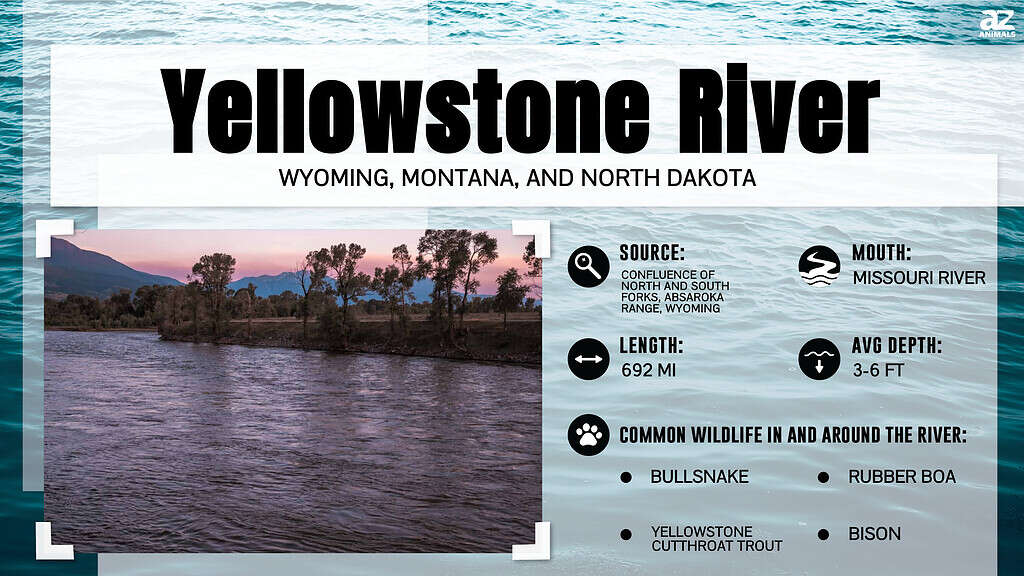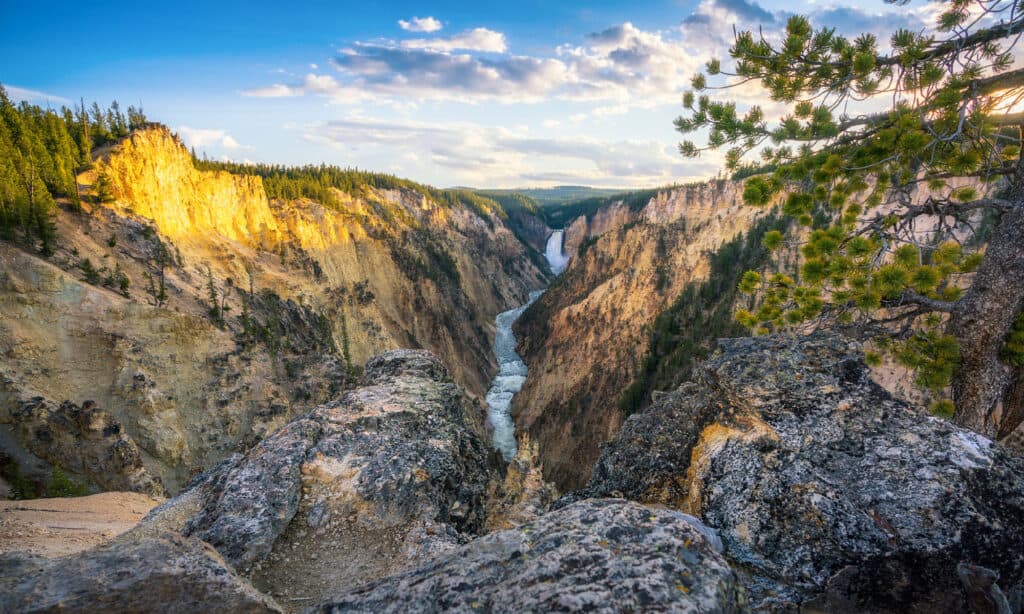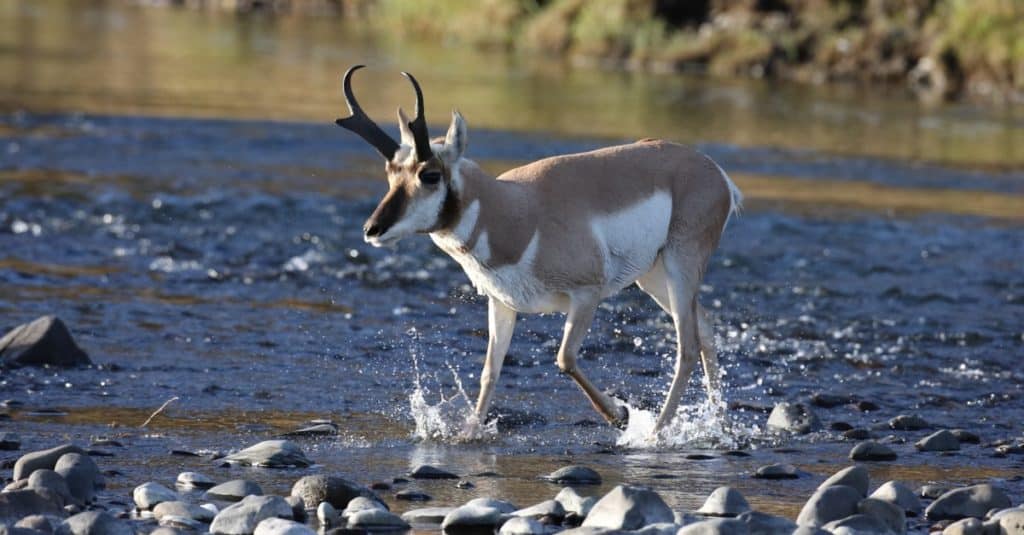
Rivers are the land’s lifeblood, pumping fresh water through rock and soil. They provide shelter and food for animals and serve as important trade routes and resources for communities.
Nestled in the rocky foothills and grassy plains of the western United States, the Yellowstone River is a pristine example of an untamed river. It winds through rocky canyons and foothills, down waterfalls, and along grass plains.
As the principal tributary of the Missouri River, the Yellowstone River serves an essential ecological function for the greater Midwest. It also supports numerous endemic and non-native plants and animals, which makes it worth protecting in its own right.
Let’s chart the course of the Yellowstone River from start to finish, including an examination of what states it flows through. In addition, we’ll discuss what makes the river so important and explore the factors threatening its existence.
Where Does the Yellowstone River Start?

The Yellowstone River starts in Wyoming.
©Cavan-Images/Shutterstock.com
Like most rivers, the Yellowstone River is formed through the combination of several smaller waterways. These waterways can shift and move over time but generally follow the same course. This is especially true with unregulated rivers that can regularly flood and change the surrounding landscape.
The Yellowstone River’s origins begin in northwestern Wyoming. The river starts in the Absaroka Range, foothills of the Rocky Mountains in southwestern Park County. Two forks come together to form the Yellowstone River: the North Fork, which flows from Younts Peak, and the South Fork, which flows from the southern slopes of Thorofare Mountain. The forks converge on the western slopes of Younts Peak to form the Yellowstone River.
From there, the Yellowstone River flows northward through Yellowstone National Park. It drains into Yellowstone Lake and then drops over the Upper and Lower Yellowstone Falls into the Grand Canyon of Yellowstone. The river continues its way north and eastward as it seeks lower ground.
What States Does the Yellowstone River Flow Through?
From start to finish, the Yellowstone River flows through three states. It originates in northwestern Wyoming, flows into southern and eastern Montana, and terminates in western North Dakota. The longest stretch of the river is located in Montana, where it runs through several cities on its journey northward. Some of the larger towns and cities along the river’s path include Livingston, Billings, Miles City, Glendive, and Sidney.
Where Does the Yellowstone River End?

The end of the Yellowstone River is in North Dakota.
©iStock.com/ChrisB
The Yellowstone River winds its way northeast from northwestern Wyoming into southern and eastern Montana. After several hundred miles, it eventually crosses the Montana-North Dakota border and continues northward. However, just a few miles after crossing into North Dakota, the mouth of the Yellowstone River meets the Missouri River.
The two rivers connect near Buford, around 25 miles west of Williston, North Dakota. The town gets its name from Fort Buford, a United States Army Post located at the confluence of the Yellowstone and Missouri Rivers. From there, the waters of the Yellowstone River mix with the Missouri River on its journey east and south. The Missouri River ultimately meets up with the Mississippi River at St. Louis, Missouri, which then flows south to its mouth in southern Louisiana and empties into the Gulf of Mexico.
How Long is the Yellowstone River?
All told, the Yellowstone River measures approximately 692 miles long. It passes through three states until it eventually empties into the Missouri River. Even then, the waters of Yellowstone don’t stop and eventually find their way south to the Gulf of Mexico.
The Yellowstone River also passes through considerable elevation changes on its journey. Elevations at the headwaters exceed 12,800 feet above sea level. Meanwhile, the confluence at the Missouri River occurs at only 1,850 feet above sea level, a difference of nearly 11,000 feet. Moreover, the Yellowstone River watershed covers an area of 37,167 square miles, covering northern Wyoming, southern and eastern Montana, and western North Dakota.
Animals Found in Yellowstone River
Yellowstone river is home to over 200 different species of animals. These animals range anywhere from bald eagles to grizzly bears to bison, wolves, elk, and even bears!
Not just that, but Yellowstone river is home to 300 bird species, 16 fish species, six reptiles and four didn’t amphibians. That is a huge ecosystem full of wildlife!
Here is a list of a few other animals found in the area:
- American bison: The bison population fluctuates in the region from about 2,300 to 5,500 animals.
- Bears: Yellowstone is home to two different species of bear, the grizzly and black bears.
- Bighorn sheep: Bighorn sheep occupy the trails through the rougher areas. There are about 500 of these animals in Yellowstone.
- Bobcats: Bobcats and lynx are both found in the region.
- Canada lynx: The lynx is one of three different cat species that can be found in Yellowstone.
- Coyotes: Yellowstone coyotes are one of the largest species of coyotes in the United States.
- Elk: This animal is the most prominent creature that can be found in Yellowstone.
Is the Yellowstone River the Longest River in the Region?
In terms of length, the Yellowstone River can’t compare to the mighty Missouri, which measures 2.341 miles long. Additionally, several other regional rivers measure longer than the Yellowstone River, even in the states it passes through. For example, the Snake River and Green River both pass through Wyoming and measure 1,040 miles and 760 miles, respectively.
That said, the Yellowstone River outranks all these rivers in one category. Unlike the Green, Snake, and Missouri Rivers, the Yellowstone River is completely un-dammed. As a result, it holds the record for the longest undammed river in the lower 48 states.
Why is the Yellowstone River Important?

Yellowstone River supports plants and animals.
©Frank Fichtmueller/Shutterstock.com
The Yellowstone River serves as the main tributary to the Missouri River, one of the most critical waterways in the United States. However, the river’s importance extends beyond just its function as a tributary.
For hundreds of years, Native American tribes lived and hunted around the fertile banks of the Yellowstone River. The Cheyenne, Crow, Cree, and Lakota Sioux all possessed summer hunting grounds in different spots along the river in southern and eastern Montana. In addition, the river served as an important means of transportation for setters who came to the region to hunt, trap, mine gold, and farm. Many settlers arrived in the area on riverboats and used the waters to transport goods and services to and from back east.
Today, the Yellowstone River supports plants and animals. The river is recognized as one of the best trout fishing spots in the world and is home to numerous species, including, rainbow, brown, and cutthroat trout. You can also find endangered endemic species in its waters, such as the pallid sturgeon. Many birds and mammals also rely on the Yellowstone to provide them with food, which only further underscores the important role the river plays in maintaining the biological health of the region.
What Threatens the Yellowstone River?
While flooding and droughts periodically affect the volume and flow of the river, these events happen rarely and are relatively benign. The greatest threats to the Yellowstone River come from human activities.
Several oil spills have occurred along the river, once in 2011 and again in 2015. The 2011 ExxonMobil oil spill dumped around 63,000 gallons of oil into the river. Even worse, the 2015 oil spill sent around 190,000 gallons into the river by some estimates. These spills required parts of the river to be temporarily closed and negatively impacted the people and animals that live in and around the river. At several other times, the river also closed due to mass die-offs of fish caused by contagious diseases.
The photo featured at the top of this post is © sirtravelalot/Shutterstock.com
Thank you for reading! Have some feedback for us? Contact the AZ Animals editorial team.






